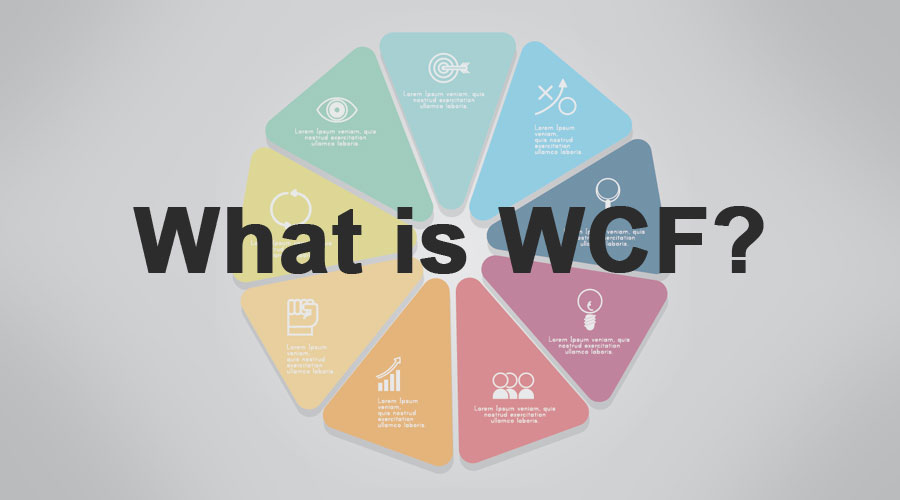Updated June 3, 2023

Introduction to WCF
The acronym WCF stands for Windows Communication Foundation. It is mainly part of the .Net framework. Developers use it for developing service-oriented applications. You can use it to create and consume services. WCF provides the platform for building and deploying various distributed network services. It mainly consists of Address, Binding, and contracts, known as ABC for WCF. There are several ways to host a WCF service, such as hosting it in IIS, self-hosting it, or using a Windows activation service.
Why should WCF be used?
WCF service is easy to use, and it is flexible as well. You can host this service in IIS, self-hosting, and Windows activation service. It supports various protocols like HTTP, WS-HTTP, TCP, P2P, MSMQ, named pipes, etc. It is a service that helps in message exchange in XML format using HTTP protocol for interoperability, and it also acts as a remoting service to exchange the message in binary format using TCP protocol for performance. WCF service helps communicate with people or exchange data with the help of chat. It supplies the data to monitor the service like a traffic report. It is one of the security services to process the transactions. Some application uses this service to get the latest data feed and put the data into a logical and visual representation.
Features of WCF
Below, we mention the features of WCF:
- It supports service-oriented architecture.
- It supports multiple transport and encoding.
- Multiple message patterns.
- Data contracts.
- Service Metadata.
- Durable messages.
- Reliable and Queued messages.
- Ajax and Rest Support.
Advantages of WCF
Below, we mention the advantages of WCF:
- It follows a service-oriented approach.
- It is platform-independent.
- Language and location have no bearing on it.
- It can maintain the transactions.
- WCF controls concurrency.
- It is one of the fastest communication technology.
- It provides excellent performance.
- You can configure it to work independently.
- It helps in maintaining the state.
- It can be hosted via several means (IIS, WAS, Self-hosting)
WCF Service Components
The WCF service’s main components for creating and consuming the service are Address, Binding, and Contracts. It is also called an endpoints. These are explained below:
- Address: The address of the service will define where to send the messages. It identifies the endpoint and determines where the service is located. An URL (Uniform Resource Locator) property defines the address of the service. It’s mainly divided into four parts:
- Schema: This is the first part of the address. It is primarily “HTTP:”
- Machine: It can be a URL like “localhost.”
- Port: It is optional and tells which port it should hit.
- Path: To locate the service files.
- Binding: It will define the communication of the client to the service. We use the protocol for communication with the client. You can use different protocols based on the requirement. The binding mainly consists of three things that are mentioned below:
- Protocol: It primarily defines the binding, such as security or transaction.
- Transport: It mainly defines the base protocol used for communication like TCP, HTTP, MSMQ and named pipes, etc.
- Encoding: Determining whether to use text or binary format when sending data is essential.
- Contracts: The contracts provide the types of operations and structure allowed between the client and service on which they agreed for the communication process. It mainly takes care of the type of operations, message form, input parameters and data, and response of the message. It is of many types that are mentioned below:
- Data Contract: It defines the type of variable that will be used for the WCF service. We use a data contract to serialize and deserialize the data. It assists in determining the data format that the service must pass. It maps the common language runtime type to an XML schema. A system for version control is used to manage data. To define a data contract, use [DataContract] and [DataMember] attributes.
- Service Contract: It defines the operations that it exposes to others. The service employs it as an interface. It represents the namespace and name of the service. It is illustrated with the [ServiceContract] attribute
- Operation Contract: It defines the method through which the server and client exchange information. The developer tells the client that they will provide the functionality. It is defined with the [OperationContract] attribute.
- Message contract: It defines the message elements that need to be passed, like a message header and a message body. It provides high-level security to messages as well. It is defined with the [MessageContract] attribute.
- Fault contract: It defines the error raised by the service and how to handle it. It is defined with the [FaultContract] attribute.
Career Growth
.NET developers and projects extensively employ WCF for creating and consuming services. The individual with the skill of WCF and .Net framework is earning a good salary and has a great range of opportunities available in the market. Many organizations only work with Microsoft technologies, and WCF is one of the most used technologies. Job seekers for this skill can look for opportunities through various platforms and grow their careers in this technology.
Conclusion
WCF is simple and easy to learn. It primarily serves the purpose of building SOAP services. It is very secure and uses the data to show in logical representation. Using this service is preferable to using a web service due to its reliability and quality. It is flexible, provides many features for developing the service, and is easy to consume. Its architecture is not complex. The programmers used this service because of its features and advantages mentioned above.
Recommended Article
This has been a guide to What is WCF. Here we discussed the Basic concepts, working, and architecture with the advantage of WCF. You can also go through our other suggested articles to learn more –
